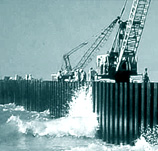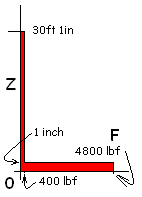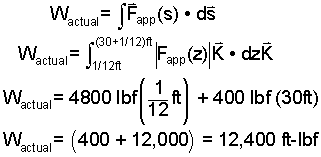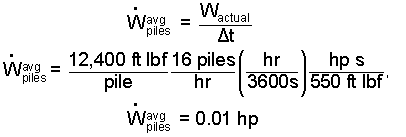| THERMO Spoken Here! ~ J. Pohl © | TOC NEXT ~ 1 |
Pulling Sheet Piling

Sheet piling are driven to form temporary barriers in waterways, to put in bridge footers, to lay fuel lines and such. Once placed, the longer the piles remain (especially in salt water), the greater the headache they are to remove. Worth salvage, the embedded piles must come out, one at a time with their connecting edges intact. By watching a load gage mounted on the drag-line boom, experienced operators can decide when salvage is worth the wear that removing them will put on the lifting machine. Sometimes the piles are pulled and scrapped.

A laborer connects the boom cable to a pile. Then the operator powers-up the machine. The load sketch shows the machine lift force versus (z), the upward displacement of the top of the pile. The first inch, while the pile breaks free, taxes the equipment the most.
Calculate the weight of a sheet pile. When the pile is lifted the elevation of its top is 30 feet one inch and the lift force is 400 lbf. Thus:


Estimate the work required to extract one piling.

Calculate the horsepower expended.
♦ About 16 piles per hour are connected, lifted then disconnected. There are great losses between the horsepower rating of an engine and what actually gets done.

Next we use the Mean Value Theorem of calculus:



Pulling Sheet Piling
Sheet piling are used to construct temporary barriers in waterways to put in bridge footers, lay fuel lines and such. Once placed, the longer those piles remain (especially in salt water), the greater the headache they are to remove. Worth salvage, the embedded piles must come out, one at a time with their connecting edges intact. By watching a load gage mounted on the drag-line boom, experienced operators can decide when salvage is worth the wear that removing them will put on the lifting machine. Sometimes the piles are pulled and scrapped.
Premise presently unwritted!